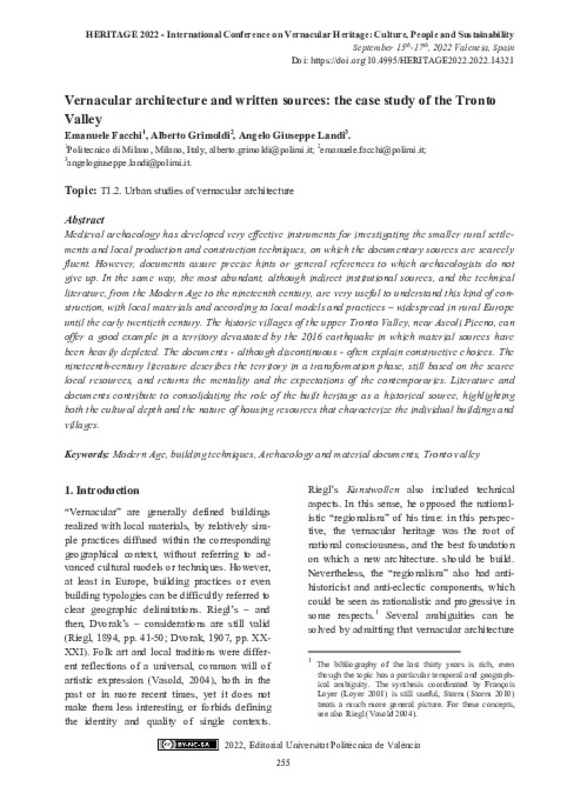JavaScript is disabled for your browser. Some features of this site may not work without it.
Buscar en RiuNet
Listar
Mi cuenta
Estadísticas
Ayuda RiuNet
Admin. UPV
Vernacular architecture and written sources: the case study of the Tronto Valley
Mostrar el registro sencillo del ítem
Ficheros en el ítem
| dc.contributor.author | Facchi, Emanuele
|
es_ES |
| dc.contributor.author | Grimoldi, Alberto
|
es_ES |
| dc.contributor.author | Landi, Angelo Giuseppe
|
es_ES |
| dc.coverage.spatial | east=13.7512734; north=42.8639969; name=Colli del Tronto AP, Itàlia | es_ES |
| dc.date.accessioned | 2022-11-23T13:27:59Z | |
| dc.date.available | 2022-11-23T13:27:59Z | |
| dc.date.issued | 2022-09-13 | |
| dc.identifier.isbn | 9788413960203 | |
| dc.identifier.uri | http://hdl.handle.net/10251/190106 | |
| dc.description.abstract | [EN] Medieval archaeology has developed very effective instruments for investigating the smaller rural settlements and local production and construction techniques, on which the documentary sources are scarcely fluent. However, documents assure precise hints or general references to which archaeologists do not give up. In the same way, the most abundant, although indirect institutional sources, and the technical literature, from the Modern Age to the nineteenth century, are very useful to understand this kind of construction, with local materials and according to local models and practices – widespread in rural Europe until the early twentieth century. The historic villages of the upper Tronto Valley, near Ascoli Piceno, can offer a good example in a territory devastated by the 2016 earthquake in which material sources have been heavily depleted. The documents - although discontinuous - often explain constructive choices. The nineteenth-century literature describes the territory in a transformation phase, still based on the scarce local resources, and returns the mentality and the expectations of the contemporaries. Literature and documents contribute to consolidating the role of the built heritage as a historical source, highlighting both the cultural depth and the nature of housing resources that characterize the individual buildings and villages. | es_ES |
| dc.format.extent | 8 | es_ES |
| dc.language | Inglés | es_ES |
| dc.publisher | Editorial Universitat Politècnica de València | es_ES |
| dc.relation.ispartof | Proceedings HERITAGE 2022 - International Conference on Vernacular Heritage: Culture, People and Sustainability | |
| dc.rights | Reconocimiento - No comercial - Compartir igual (by-nc-sa) | es_ES |
| dc.subject | Modern Age | es_ES |
| dc.subject | Building techniques | es_ES |
| dc.subject | Archaeology and material documents | es_ES |
| dc.subject | Written documents | es_ES |
| dc.subject | Tronto valley | es_ES |
| dc.title | Vernacular architecture and written sources: the case study of the Tronto Valley | es_ES |
| dc.type | Capítulo de libro | es_ES |
| dc.type | Comunicación en congreso | es_ES |
| dc.identifier.doi | 10.4995/HERITAGE2022.2022.14321 | |
| dc.rights.accessRights | Abierto | es_ES |
| dc.description.bibliographicCitation | Facchi, E.; Grimoldi, A.; Landi, AG. (2022). Vernacular architecture and written sources: the case study of the Tronto Valley. En Proceedings HERITAGE 2022 - International Conference on Vernacular Heritage: Culture, People and Sustainability. Editorial Universitat Politècnica de València. 255-262. https://doi.org/10.4995/HERITAGE2022.2022.14321 | es_ES |
| dc.description.accrualMethod | OCS | es_ES |
| dc.relation.conferencename | HERITAGE2022 International Conference on Vernacular Heritage: Culture, People and Sustainability | es_ES |
| dc.relation.conferencedate | Septiembre 15-17, 2022 | es_ES |
| dc.relation.conferenceplace | Valencia, España | es_ES |
| dc.relation.publisherversion | http://ocs.editorial.upv.es/index.php/HERITAGE/HERITAGE2022/paper/view/14321 | es_ES |
| dc.description.upvformatpinicio | 255 | es_ES |
| dc.description.upvformatpfin | 262 | es_ES |
| dc.type.version | info:eu-repo/semantics/publishedVersion | es_ES |
| dc.relation.pasarela | OCS\14321 | es_ES |








